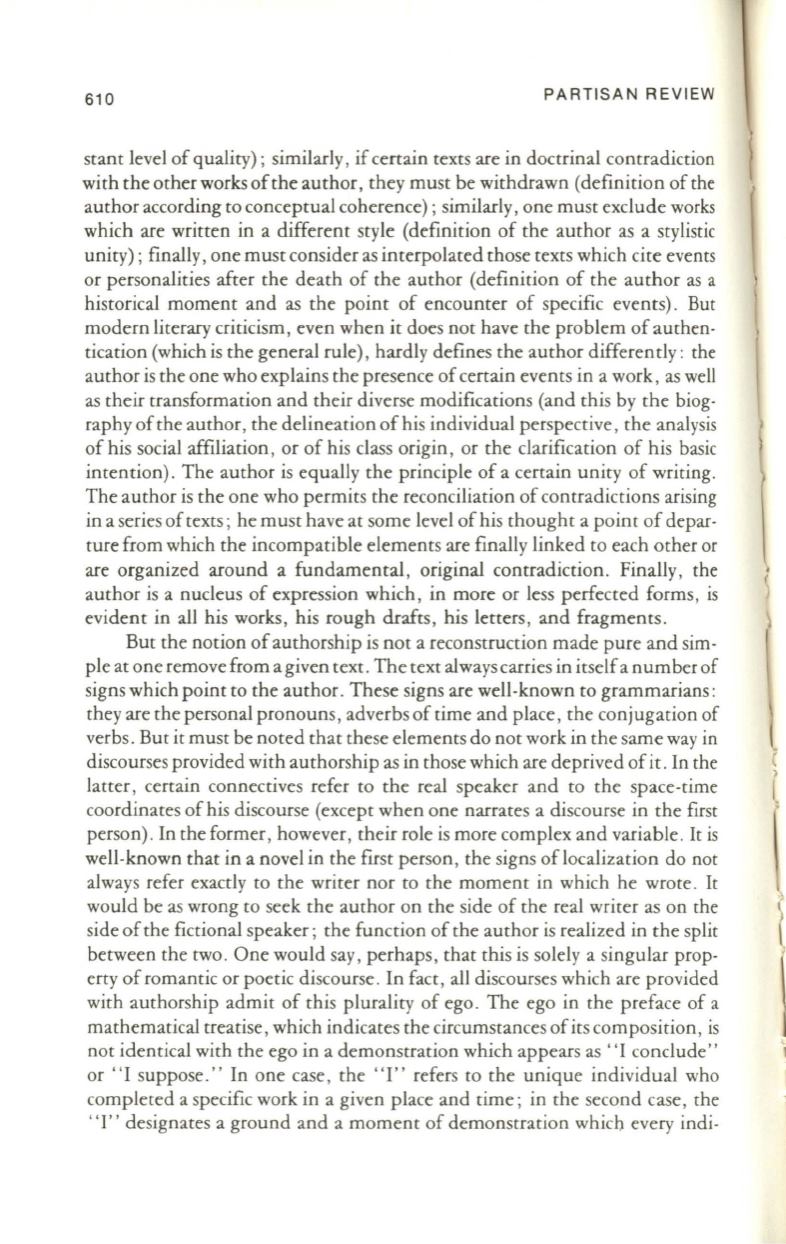
610
PARTISAN REVIEW
stant level of quality); similarly, if certain texts are in doctrinal contradiction
with the other works of the author, they must be withdrawn (definition of the
author according to conceptual coherence); similarly, one must exclude works
which are written in a different style (definition of the author as a stylistic
unity) ; finally, one must consider as interpolated those texts which cite events
or personalities after the death of the author (definition of the author as a
historical moment and as the point of encounter of specific events) . But
modern literary
criticism,
even when
it
does not have the problem of authen–
tication (which is the general rule), hardly defines the author differently: the
author is the one who explains the presence of certain events
in
a work, as well
as their transformation and their diverse modifications (and this by the biog–
raphy of the author, the delineation of his individual perspective , the analysis
of his social affiliation, or of his class origin, or the clarification of his basic
intention) . The author is equally the principle of a certain unity of writing.
The author is the one who permits the reconciliation of contradictions arising
in a series of texts; he must have at some level of his thought a point of depar–
ture from which the incompatible elements are finally linked
to
each other or
are organized around a fundamental, original contradiction . Finally, the
author is a nucleus of expression which, in more or less perfected forms, is
evident in all his works,
his
rough drafts, his letters, and fragments .
But the notion of authorship is not a reconstruction made pure and sim–
ple at one remove from a given text . The text always carries in itself a number of
signs which point to the author . These signs are well-known to grammarians:
they are the personal pronouns, adverbs of time and place , the conjugation of
verbs . But it must be noted that these elements do not work in the same way in
discourses provided with authorship as in those which are deprived of it . In the
latter, certain connectives refer
to
the real speaker and to the space- time
coordinates of his discourse (except when one narrates a discourse in the first
person) . In the former , however, their role is more complex and variable . It is
well-known that in a novel in the first person, the signs of localization do not
always refer exactly
to
the writer nor to the moment in which he wrote . It
would be as wrong to seek the author on the side of the real writer as on the
side of the fictional speaker; the function of the author is realized in the split
between the two . One would say , perhaps, that this is solely a singular prop–
erty of romantic or poetic discourse . In fact , all discourses which are provided
with authorship admit of this plurality of ego. The ego in the preface of a
mathematical treatise, which indicates the circumstances of its composition , is
not identical with the ego in a demonstration which appears as " I conclude "
or "I suppose. " In one case , the "1" refers to the unique individual who
completed a specific work in a given place and time ; in the second case, the
.T '
designates a ground and a moment of demonstration which every indi-
\
l
(
)
I


